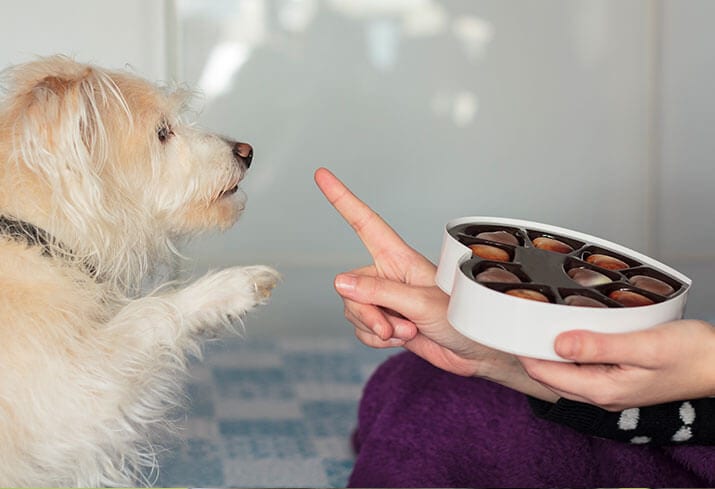As most dog owners know (and if you didn’t, you do now), dogs should not have chocolate. But why? Many owners wonder, what is in chocolate that is so often enjoyed by humans, but can be so harmful to dogs? And more importantly, if your dog does accidentally ingest chocolate, what is the best course of action? What should you, the owner, do to help your pet?
Read on to find out!
Why is Chocolate Toxic for Dogs?
There are several things contained in chocolate that are completely fine for humans to consume but can be very harmful for dogs. Chocolate contains both caffeine and a substance called theobromine. Theobromine is an alkaloid chemical and a stimulant. This combined with caffeine can speed a dog’s heart rate to dangerous levels, as well as stimulate their nervous system. However, the concentrations of these chemicals can vary between different types of chocolate. All are potentially poisonous to dogs, but some are more poisonous than others because they contain higher concentrations of caffeine and theobromine. For example, straight cocoa powder is the most toxic to dogs, as it has the highest concentrations of these chemicals, followed by baker’s chocolate, semi-sweet chocolate, dark chocolate, and milk chocolate, which has the lowest concentration of caffeine and theobromine.
If your dog has accidentally ingested chocolate, it’s extremely important for you, the owner, to know firstly what type of chocolate they’ve ingested, and also how much of it in order to determine if it’s a medical emergency or not.
Certain dogs are at higher risk for chocolate poisoning. The smaller the dog, the less chocolate it will be able to consume without risk of death. A dose that may cause only diarrhea and discomfort in a larger dog could be fatal for a smaller dog. In addition, older dogs or dogs with existing health conditions may not be able to handle much chocolate at all and will be able to tolerate less than a young, healthy dog.
In an average sized dog of good health, a crumb of chocolate cake might not hurt too bad, but a square of milk chocolate might. And it would be even worse for smaller dogs, or dogs in ailing health. Chocolate should never be given to dogs on purpose, even larger dogs, and in small amounts.
Symptoms of Chocolate Poisoning in Dogs
If your dog has eaten chocolate, symptoms will usually start to appear within 6 to 12 hours of ingestion and can last up to 72 hours. Symptoms can range from mild symptoms, such as restlessness or diarrhea, to more severe symptoms like cardiac arrest, and even death. Here is the complete list of symptoms of chocolate poisoning in dogs:
- Diarrhea
- Restlessness or discomfort
- Vomiting
- Shaking
- Increased urination
- Increased or abnormal heart rate
- Seizures
- Collapse
- Death
What to Do If Your Dog Eats Chocolate
The first thing to do if you believe your dog has eaten chocolate is to call your Northern Pike Veterinary Hospital vet at 412-373-8580 and/or the Pet Poison Helpline (888-426-4435) immediately. They are trained to deal with situations such as this and will be able to direct you towards help for your pet.
Based the size of your dog, the type of chocolate consumed, and the amount, several different things may happen. They may advice you to wait, and monitor your dog, if the dose was not severe. Or, if the amount could be life threatening for your dog, they may ask that you take your pet to the emergency vet.
If your dog is in immediate danger and you’re asked to bring them in, there are many things your veterinarian may do for them. If the dose was recent enough that it’s still mostly contained to the stomach, your veterinarian may induce vomiting. Your veterinarian may also give your dog capsules of activated charcoal, which help remove toxins. In extremely life-threatening cases, your dog may require medications or an IV of fluids, and your veterinarian may need to monitor them overnight or longer.
How to Prevent Your Dog from Eating Chocolate
Although accidents do happen, there are several things you can do to help prevent your dog from ingesting chocolate.
Keep Chocolate Out of Reach
The best thing you can do to minimize the risk of your dog encountering chocolate poisoning in your household is to keep the chocolate and other harmful foods in a place where your dog can’t reach them. Don’t keep chocolate in low cupboards, on top of tables, or anywhere else where your dog could get to it while you’re not home. Instead, opt for high cupboards, and dog-proof locking mechanisms. Also, try to keep purses, Easter baskets, trick-or-treat bags, and other chocolate-containing accessories off countertops and away from the floors.
Train Them to “Drop It”
Teaching the command “drop it” or “leave it” can be especially beneficial for your dog’s health, as it can teach them not to pick up things they find on the ground. In addition, this command is easy to teach, and training dogs is proven to increase their lifespan!
Crate Train
Crate training your dog can be very helpful, especially if you’re someone who may have to leave your dog unsupervised for amounts of time. It’s best to start crate training when your dog is young, but better late than never! You’ll need a comfortable, sturdy crate, with a good solid latch, big enough that your dog can stand up and move around. You’ll also want to make sure and put the crate somewhere comfortable—not too hot or too cold, without any drafts or other adverse environmental qualities. This will be the place your dog can go when they want to be alone, as well as a place for you to place them when you can’t supervise, so your dog should feel safe and comfortable here. Make sure to place treats, toys, and maybe even a favorite blanket in here, so that it will become a place your dog enjoys being when you can’t watch them.


